Knowledge
Discover The Best Lats Exercise
Articles, Muscle gain

Discover The Best Lats Exercise
Building big and wide lats is something that most people fail to do and it’s not because they aren’t trying. After all, a wide back makes you look a lot bigger. I’ve always said that round shoulders and a wide back are what makes an upper-body impressive: it makes you look muscular regardless of what you are wearing. Despite that, you rarely see people with well-developed lats. It’s simply hard to hit them properly: other muscles will compensate (rhomboids, rear deltoids, biceps, traps) and as such you just reinforce the habit of not using the lats exercise.
The lat pulldown (or pull up) supposedly involves the lats more because the pulling angle takes out the rhomboids and traps significantly. But I’ve never liked to use a lot of vertical pulling because it puts the shoulder in a position that could potentially contribute to shoulder problems. Not only that, but I’ve never felt like I could really emphasize the eccentric on those movements because whenever I tried, the biceps and brachialis always seemed to take over.
Since I’m traps dominant, building my lats has always been difficult for me and I’ve experimented with tons of movements. I love straight-arm pulldowns because they really allow me to isolate my lats, but I still want to use pulling patterns to stimulate them.
So, after a lot of experimentation here is the exercise that I find to be the best to build my lats:
Accentuated Eccentric Seated Row
This lats exercise allows you to increase lats activation by emphasizing all three contraction types: concentric, isometric and eccentric.
It uses a method developed by Jerry Telle (Tellekinetics) in which you change your body position during the execution of the exercise to maximize muscle tension at all times.
In the accentuated eccentric seated row you do the concentric (pulling) phase with a slight backward angle to the torso. This will allow you to lift the most weight. Really focus on pulling with your lats (so keep your shoulders down and pull to your navel).
Once the weight is pulled to your stomach you will hold it there while you are changing position smoothly by slowly bending forward. It’s important to keep pulling hard otherwise your arms will begin to move forward, which defeats the purpose of the lats exercise.
When you reach the more bent over the position you will slowly bring the handle back to the starting position.
Why Is It Effective?
The number one reason why it works so well to build your lats is that you shift most of the tension to the lats during the eccentric portion of the movement: by leaning forward you dramatically reduce the participation of the traps and rhomboids to the movement, leaving the eccentric portion to be done mostly by the lats.
To shift the tension to the lats, even more, push down (toward your feet) while you are returning the handle to the starting position. This will take the biceps out of the action a little bit.
The second reason why it’s great at building the lats is the isometric hold when you are shifting position. This smoothly transitions the tension to the lats. You can recruit up to 10% more muscle fibres during an isometric action. So in that “hold” portion, you are turning on more muscle fibres in the lats and you keep them turned on during the execution of the lift. As such you will recruit, fatigue and stimulate more muscle fibres.
In the past, I used to do a lot of rowing with a bent-over position (motorcycle rows). While it worked well to improve the mind-muscle connection with the lats, I could never use a lot of weight. With the accentuated eccentric row I can use more weight while still getting the same (if not better) mind-muscle connection. It’s a big win!
Conclusion
If you have problems making your lats wider and thicker, simply pulling big weights will not be enough. In fact, if you are traps (or mid-back) dominant, doing those big heavy rows will only amplify your strengths, making your weaknesses proportionally weaker and less likely to be targeted.
The accentuated eccentric seated row allows you to bridge the gap between heavy pulling and mind-muscle connection work. To this day, it is still my favorite lats exercise.
– CT